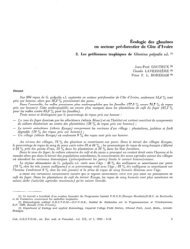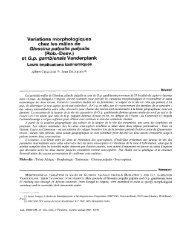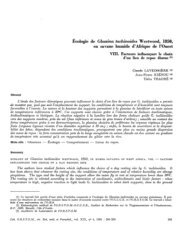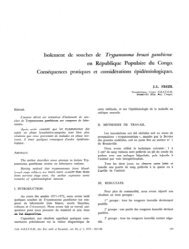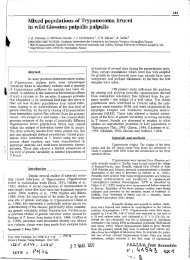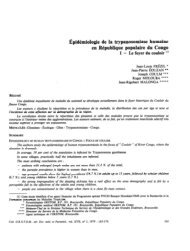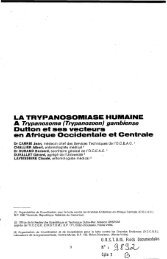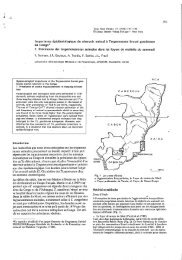Genetic and Morphometric Evidence for Population Isolation of ... - IRD
Genetic and Morphometric Evidence for Population Isolation of ... - IRD
Genetic and Morphometric Evidence for Population Isolation of ... - IRD
You also want an ePaper? Increase the reach of your titles
YUMPU automatically turns print PDFs into web optimized ePapers that Google loves.
September 2006 CAMARA ET AL.: ISOLATION OF A TSETSE POPULATION 859<br />
The F st value measured among the three populations<br />
was positive <strong>and</strong> signiÞcant, indicating genetic<br />
differentiation among the three populations. Pairwise<br />
Cavalli-S<strong>for</strong>za <strong>and</strong> Edwards chord distances always<br />
distinguished the sample from Loos isl<strong>and</strong>s from the<br />
two other samples, whereas this same distance was the<br />
lowest <strong>and</strong> was not signiÞcant when measured between<br />
the two samples from the mangrove. When the<br />
two mainl<strong>and</strong> populations were grouped <strong>and</strong> compared<br />
with the those from the isl<strong>and</strong>, F st value was<br />
nearly 2 times higher (0.057) than the value comparing<br />
the three populations (0.032). Taking into account<br />
the high degree <strong>of</strong> polymorphism <strong>of</strong> our microsatellite<br />
loci, <strong>and</strong> using the suggestion <strong>of</strong> Hedrick (1999, 2005)<br />
<strong>for</strong> a st<strong>and</strong>ardized estimate (F st’ F st /F st max with<br />
F st max F st /(1 H s ) provided a corrected estimate<br />
<strong>of</strong> 0.34. Despite being relatively high, this upper bound<br />
seems far from 1, suggesting that either there are some<br />
migrants (e.g., one effective migrant each four generations),<br />
or there have been migrants in the past, <strong>and</strong><br />
the separated populations did not yet reach equilibrium.<br />
According to markÐrecapture experiments on<br />
G. palpalis (Cuisance et al. 1985, Bouyer et al. 2007),<br />
ßies should be able to reach a distance <strong>of</strong> 30 km if the<br />
populations had been separated by homogeneous riverine<br />
<strong>for</strong>est. But given the geographic location <strong>of</strong> our<br />
study, it seems unlikely <strong>for</strong> them to actively disperse<br />
from the isl<strong>and</strong>s to the mangrove or vice versa. However,<br />
passive transport by the numerous boats in the<br />
area cannot be ruled out. Our working hypothesis is<br />
that tsetse from the mangrove colonized the Loos<br />
isl<strong>and</strong>s probably by passive transport, <strong>and</strong> probably at<br />
the time when the isl<strong>and</strong>s harbored important economic<br />
activities such as the bauxite exploitation, <strong>and</strong><br />
the Conakry peninsula harbored natural mangrove<br />
vegetation. The frequency <strong>of</strong> passive tsetse exchanges<br />
probably dropped with the regression <strong>of</strong> economic<br />
activities <strong>and</strong> the degradation <strong>of</strong> this vegetation. According<br />
to that hypothesis, both low migration rates<br />
<strong>and</strong> small population sizes would have contributed to<br />
the observed genetic differentiation.<br />
Metric properties are under the inßuence <strong>of</strong> both<br />
environmental <strong>and</strong> genetic factors, <strong>and</strong> as continuous<br />
traits they are among the earliest characters to change<br />
between physically separated populations (Falconer<br />
1981). Environment typically acts primarily on size<br />
(Glasgow 1961) <strong>and</strong> then on shape, frequently as an<br />
allometric effect <strong>of</strong> size change (Dujardin <strong>and</strong> Le Pont<br />
2004). The three populations were not distinct on the<br />
base <strong>of</strong> size, but they could be discriminated by shape<br />
variation. In our data, although some residual allometry<br />
was found due to sexual dimorphism typical <strong>of</strong><br />
tsetse species (Sané et al. 2000, de La Rocque et al.<br />
2002), no allometric effect was detected to explain the<br />
shape discrimination between isl<strong>and</strong> <strong>and</strong> mainl<strong>and</strong><br />
populations. Pure shape differences among conspeciÞc<br />
populations are more likely to result from adaptive<br />
or genetic causes than from environmental effects<br />
(Dujardin <strong>and</strong> Slice 2006). This interpretation <strong>of</strong> metric<br />
variation was supported by the detection <strong>of</strong> directional<br />
asymmetry (<strong>and</strong> possibly antisymmetry) only in<br />
the isl<strong>and</strong> population, although limited to the females.<br />
Directional asymmetry is a heritable trait very common<br />
in Diptera (Klingenberg et al. 1998), <strong>and</strong> the<br />
Þnding <strong>of</strong> intraspeciÞc variability in this trait also suggests<br />
genetic differences.<br />
Data from microsatellites <strong>and</strong> from wing geometry<br />
both converged to the idea <strong>of</strong> a separation <strong>of</strong> the Loos<br />
isl<strong>and</strong> population from the mainl<strong>and</strong>. The level <strong>of</strong><br />
separation in terms <strong>of</strong> number <strong>of</strong> migrants per generation<br />
seems high, which con<strong>for</strong>ms to the known dispersing<br />
behavior <strong>of</strong> the insect. Although occasional<br />
contacts cannot be excluded, our working hypothesis<br />
is that the Loos population <strong>of</strong> tsetse ßies is a completely<br />
isolated population. If true, this situation will<br />
favor control interventions, with the possibility <strong>of</strong><br />
eliminating tsetse from this isl<strong>and</strong>.<br />
Acknowledgments<br />
We acknowledge collaboration from the Ministry <strong>of</strong><br />
Health <strong>of</strong> Guinea, <strong>and</strong> thank A. S. Robinson <strong>for</strong> kindly providing<br />
G. palpalis microsatellite DNA sequences. This work<br />
was supported by the Leverhulme Trust Tsetse Research<br />
Network, Ministère des Affaires Etrangères <strong>of</strong> France, EU<br />
INCO-DEV project n031849, <strong>and</strong> Institut de Recherche<br />
pour le Développement.<br />
References Cited<br />
Bookstein, F. L. 1991. <strong>Morphometric</strong> tools <strong>for</strong> l<strong>and</strong>mark<br />
data: geometry <strong>and</strong> biology. Cambridge University Press,<br />
New York.<br />
Bouyer, J., A. Sibert, M. Desquesnes, D. Cuisance, <strong>and</strong> S. de La<br />
Rocque. 2007. A model <strong>of</strong> diffusion <strong>of</strong> Glossina palpalis<br />
gambiensis (Diptera: Glossinidae) in Burkina Faso. In M.J.B.<br />
Vreysen, A. S. Robinson, <strong>and</strong> J. Hendrichs [eds.], Area-wide<br />
Control <strong>of</strong> Insect Pests. From Research to Field Implementation.<br />
Springer, Dordrecht, The Netherl<strong>and</strong>s. (in press).<br />
Brengues, J., A. Challier, <strong>and</strong> V. K. Ouedraogo. 1964. Contribution<br />
à la connaissance de lÕépidémiologie de la<br />
trypanosomiase humaine: enquête entomologique dans<br />
les territoires kissis et limitrophes (avril-mai 1964: Sierra-<br />
Leone, Libéria, Guinée). OCCGE Eds, Bobo-Dioulasso,<br />
Burkina Faso.<br />
Camara, M., D. Kaba, M. Kagbadouno, J. R. Sanon, F. Ouendeno,<br />
<strong>and</strong> P. Solano. 2005. La Trypanosomose Humaine<br />
Africaine en zone de mangrove en Guinée: caractéristiques<br />
épidémiologiques et cliniques de deux foyers<br />
voisins. Méd. Trop. 65: 155Ð161.<br />
Cavalli-S<strong>for</strong>za, L. L., <strong>and</strong> A.W.F. Edwards. 1967. Phylogenetic<br />
analysis: model <strong>and</strong> estimation procedures. Am. J.<br />
Hum. Genet. 19: 233Ð257.<br />
Cuisance, D., H. Politzar, J. Fevrier, G. Bourdoiseau, <strong>and</strong><br />
E. Sellin. 1980. Association dÕun traitement insecticide<br />
avec la méthode du mâle stérile contre Glossina palpalis<br />
gambiensis: intérêt de la mise en Ïuvre de plusieurs<br />
méthodes. Rev. Elev. Méd. Vét. Pays Trop. 33: 127Ð133.<br />
Cuisance, D., J. Fevrier, J. Dejardin, <strong>and</strong> J. Filledier. 1985.<br />
Dispersion linéaire de Glossina palpalis gambiensis et.<br />
G. tachinoides dans une galerie <strong>for</strong>estière en zone<br />
soudano-guinéenne. Rev. Elev. Méd. Vét. Pays Trop. 38:<br />
153Ð172.<br />
Da Costa, B.F.P., J. F. Sant’anna, A. C. Santos, <strong>and</strong> M.G.A.<br />
Alvares. 1916. Sleeping sickness, a record <strong>of</strong> four years<br />
war against it in Principe, PortugueseWest Africa. Ballière,<br />
Tindall & Cox, London, United Kingdom.<br />
de La Rocque, S., B. Ge<strong>of</strong>froy, J. F. Michel, F. Borne,<br />
P. Solano, J. Y. Meunier, <strong>and</strong> D. Cuisance. 2002. Les ailes



